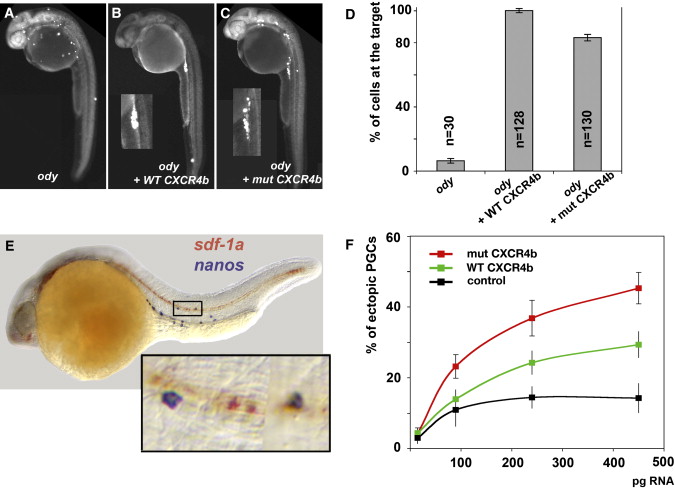Fig. 2 Control of CXCR4b Internalization and Signaling Level Is Required for Precise Arrival of PGCs at the Region where the Gonad Develops (A–C) The wild-type and mutant (mut) form of CXCR4b differ in the ability to complement the ody mutation. GFP labeled PGCs in 24 hr ody embryos (A) are scattered throughout the embryo. Expression of wild-type CXCR4b in ody PGCs allows the cells to arrive at their target by the end of the first day of development (B), whereas the mutated internalization-defective receptor (mut CXCR4b, construct 6 in Figure 1F) is less effective (C). Insets in (B) and (C) are enlarged images of the area where the gonad develops in the corresponding embryos. Cells expressing the mutant CXCR4b often form a loose cluster. (D) The percentage of correctly migrating PGCs (cells that have arrived at the region where the gonad develops) in ody embryos and in ody embryos expressing the wild-type or the mutant form (mut CXCR4b, construct 6 in Figure 1F) of CXCR4b. The error bars represent the SEM, and "n" is the number of embryos examined. (E) Whole-mount in situ hybridization of an embryo whose PGCs (nanos-1 in blue) express a mutant form of CXCR4b. PGCs arrive at various sites of sdf-1a expression (labeled in red), other than the site of the gonad. The inset shows sdf-1a expressed along the lateral line that attracts PGCs located away from their correct target (for more examples, see FigureS1). (F) Increased signaling by CXCR4b disrupts normal PGC migration. Increasing the amount of wild-type CXCR4b (green) or mutant CXCR4b (red) RNA in wild-type PGCs results in an increase in the percentage of ectopic PGCs as assessed at the end of the first day of development. vasa-DsRed-3′ UTRnos1 was used as control RNA. Error bars represent SEM. A total of 20–40 embryos were analyzed for each point.
Image
Figure Caption
Acknowledgments
This image is the copyrighted work of the attributed author or publisher, and
ZFIN has permission only to display this image to its users.
Additional permissions should be obtained from the applicable author or publisher of the image.
Full text @ Curr. Biol.

